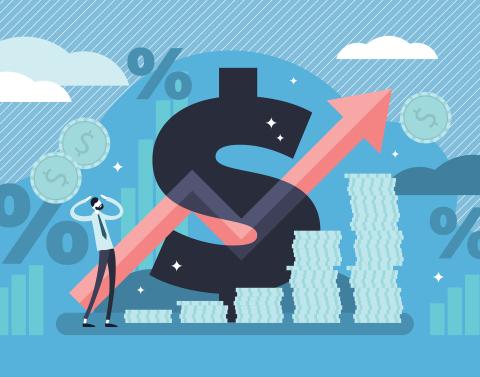Story by Rob Gerth
Image by iStock/Vectormine
Fabio Gómez-Rodríguez explains that believing is seeing.
Inflation is not a distance, it’s a speed,” according to Fabio Gómez-Rodríguez, assistant professor of economics at Lehigh Business. “Prices are rising; the problem is when they do ‘too fast.’ And consequently, when we anticipate inflation going up, it’s motivating us to spend our money right away before it loses value.”
“Don’t get me wrong,” Gómez-Rodríguez says, “inflation is not inherently bad. Businesses expand when people spend their money, generating jobs and higher wages. A little inflation is necessary for a healthy economy.”
The trick is keeping inflation steady, according to Gómez-Rodríguez. The key, he adds, is to manage inflation expectations, which is essentially what people expect inflation to be next week, next year or even the next five to ten years.
Inflation expectations are measured from surveys of consumers and professional forecasters, as well as the interpretation of investment decisions made throughout the market.
“The amazing thing is, whatever this collective thinks is going to happen ends up happening,” says Gómez-Rodríguez. “If we expect high inflation, inflation will rise. If we anticipate low inflation, inflation will decrease.”
Inflation expectations are crucial for guiding policy decisions, shaping the economy, and maintaining macroeconomic stability, according to Gómez-Rodríguez. Accurate and well-anchored expectations help foster economic growth, investment and stable prices.
“That’s why the Federal Reserve, or any central bank, will pay more attention to what’s happening with inflation expectations, trying to keep it not too high, not too low,” says Gómez-Rodríguez. (The Fed’s inflation target has held at 2% since 2012.)
“As long as inflation expectations are controlled, we can control inflation,” he says.
“Inflation expectation is the focus of my research,” says Gómez-Rodríguez. “It turns out people tend to disagree on inflation expectations.”
Gómez-Rodríguez’s research proposes studying inflation expectations from diverse perspectives instead of merely averaging everyone’s expectations. He says inflation expectations are heterogeneous.
Using statistics, econometrics, extensive survey data, machine learning, and computer codes to analyze the multiple inflation expectations of people, Gómez-Rodríguez says he has begun to answer how decisions by the Federal Reserve or the government affect the diversity of inflation expectations.
“For instance,” says Gómez-Rodríguez, “we’ve learned that low or negative inflation expectations become more common, and moderate inflation expectations become less common due to an unexpected increase in interest rates.”
He also discovered that a personal income tax hike doesn’t affect inflation expectations for the following twelve months, but rather affects inflation expectations for five to ten years ahead. Moreover, the government’s decision to increase expenditure causes inflation expectations that are higher than 10% to grow.
“It’s pretty revealing that non-monetary policy affects inflation expectations all because of the federal funds rate,” says Gómez-Rodríguez.
Gómez-Rodríguez has also studied another scenario: What happens when the price of gasoline increases? Unsurprisingly, both one-year and medium run inflation expectations rise. It’s
interesting, he says, because there’s increasing disagreement on how this affects inflation in the medium term—five to ten years.
Why it Matters
Future research could allow us to accurately predict inflation using inflation expectations and better understand the relationship between different inflation expectations and the economy.
Listen to the podcast.
Watch his This is My Research video.


